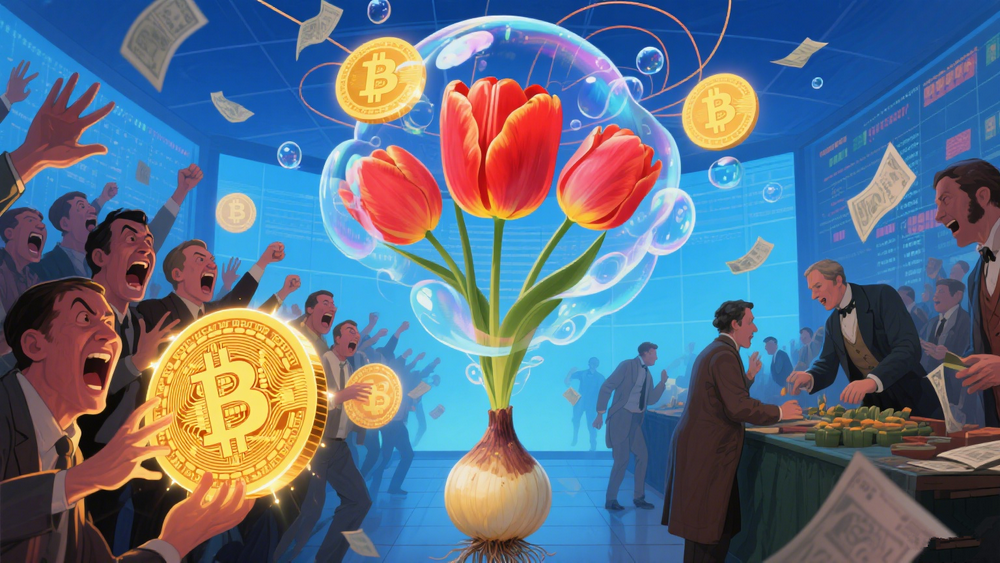Source: unlock-bc Translated by: BlockWeeks
In 17th century Netherlands, a flower sparked the first verifiable financial bubble in history—the tulip bubble.
This trend, which initially symbolized beauty and status, quickly evolved into a speculative frenzy, ultimately leaving countless people bankrupt.
Centuries later, Bitcoin soared to over $120,000, reigniting people's reflections on the comparison. A report from Al Arabiya explores the similarities between tulips and tokens, reminding everyone to be cautious—not because 'Bitcoin must be a bubble,' but because human speculative behavior often repeats.

How a flower became wealth
Tulips were introduced to Europe from the Ottoman Empire in the mid-16th century and quickly became a must-have for Dutch nobility. They were vibrant and rare, symbols of wealth and taste.
By the early 17th century, tulips had evolved from ornamental plants to speculative assets. Merchants, artisans, and even ordinary craftsmen began trading 'tulip bulb futures,' with most having never seen a real bulb.
At the peak of the frenzy in 1636, the price of a rare tulip was equivalent to a mansion in Amsterdam. Buyers no longer paid for the flower itself but bet on whether someone would offer a higher price the next day.
However, in February 1637, it suddenly collapsed: demand vanished, auctions fell silent, and prices plummeted. Prosperity turned to smoke overnight, with many fortunes lost, and the tulip bubble became a classic fable warning against speculation.
Bitcoin: The 'tulip' of the 21st century?
Fast forward to today, Bitcoin has once again surpassed expectations, with a market value exceeding $2.4 trillion, surpassing Amazon and silver, ranking as the fifth largest asset in the world.
So, has it replayed the 'tulip bubble'?
**Not completely the same.** Tulips are ultimately ornamental plants, while Bitcoin carries transformative potential. It is based on blockchain technology, constructing a decentralized monetary system—a transparent and immutable ledger that supports peer-to-peer payments; it serves as a store of value and can be used for cross-border remittances, even against inflation.
But the speculative mindset is similar: many investors buy not out of an understanding of technology or value, but out of FOMO (fear of missing out), hoping for quick profits. Social media has replaced 17th-century taverns, with rumors and price predictions spreading unchecked, fueling blind following.
How Bitcoin breaks the mold
The key difference is that Bitcoin is not a beautiful rarity, but 'programmable money.'
The underlying blockchain technology supports:
Trustless, cross-border payment
Smart contracts
Decentralized applications
Institutional investors have begun positioning themselves: hedge funds, asset management companies, and even some central banks are incorporating BTC into their reserves. Although Bitcoin's volatility is significant, it represents the common 'excitement → overheating → correction → consolidation' life cycle of technological and financial innovations.
Lessons from the past, warnings from the present
The tulip bubble is not just a piece of history, but a mirror reflecting human greed and fear, reminding us how easily rational decision-making can be obscured by the 'dream of sudden wealth.'
Bitcoin may be the 'flower' of the digital age, but it is also a test of how we face disruptive technologies. The challenge is not to dismiss every bull market with 'bubble theory,' but to combine enthusiasm with understanding.
At the threshold of the decentralized era, one thing remains unchanged: **the market is also driven by emotion. The greed, fear, and hope that fueled the tulip bubble centuries ago are still playing out in the Bitcoin market today.
Bitcoin may not be a bubble, but it is also not invulnerable—this is the most valuable lesson from history.


